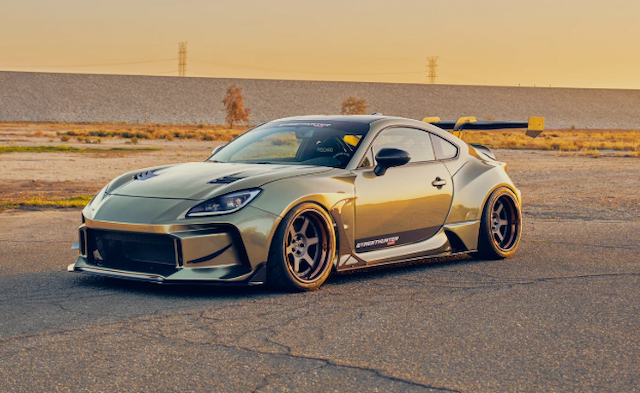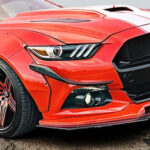Car manufacturers aren’t exactly shy about designing exteriors. Distinct styling cues define brand identity, with similar lines across multiple models. Another shared trait is the attention to detail and bodywork that works with the engine, chassis and suspension to deliver a more pleasurable driving experience.
Obvious instances are the enormous rear spoilers in performance cars like the Subaru WRX STi or Porsche GT3, or the subtle front splitters in the Lexus RCF or Chevrolet Corvette. These are factory-fitted, but car enthusiasts can source aftermarket body kits for any car, and enjoy the styling and performance benefits that singles them out of the crowd.

Body Kit Basics
Whether it’s V8 muscle cars, F1 or rally machines, or modified track cars, it’s quality car body kits that get all that power to the ground. This is a collection of exterior car parts that include front and rear bumpers, side skirts, spoilers, splitters or wheel flares as well as subtle changes to stock styling for a performance and aesthetics edge over similar models.
The goal is to improve aerodynamics, shed extra weight and give the car a ready-to-race look. How effectively they do this is down to the included parts, how these work together to deal with oncoming air and drag, what they’re made of, and of course the attention that goes into their installation.
Types of Car Body Kits
The good news for car owners is that they can completely transform the mundane looks of everyday cars, and even add a performance boost with carefully selected parts. These are packaged in different types of car body kits to meet different needs:
- Full body kits – this involves a complete exterior redesign with parts ranging from front and rear bumpers, side skirts, spoilers, wider wheel flares, bonnet scoops or lightweight roofs. Parts are matched for a cohesive look and engineered to enhance aerodynamics while increasing traction in the tyres.
- Wide body kits – for a more aggressive look and wider stance, choose wide body kits. These have wider wheel flares, protruding side skirts and bigger bumpers. The additional space allows for performance tyre and wheel combos, big brake kits and revised suspension parts that together improve road holding and braking power.
- Lip kits – these have revised front spoilers sitting lower to the ground and working with the factory bumpers to redirect oncoming air over and under the car to increase downforce. The changes may be visually subtle, but the handling benefits, especially the increased grip and steering control, definitely aren’t.
- Bumper kits – get more heads turning with bumper kits, especially in mass-produced cars like hatches and sedans. These consist of bulging front and rear bumpers, mixed with more subtle side skirts. Some can also include bigger rear spoilers for a more visual effect.
- Aero kits – if you’re serious about faster lap times, then nothing beats an aero kit. Parts here are carefully engineered to balance downforce, drag and lift and keep the car glued to the road while allowing for faster acceleration. Typical additions are splitters, front spoilers, side skirts, and rear diffusers, with subtle wings or rear spoilers keeping the rear tight in turns.
Why Materials Matter

Just like in complete engine rebuilds, the materials in body kits have a huge say in overall performance and longevity. They also impact weight and price which can vary widely. Common choices are carbon fibre, polyurethane and fibreglass. Some kits also include a mix of materials and composites to balance performance, weight and price.
Carbon fibre has exceptional strength (far outpacing steel or aluminium), is extremely light and won’t lose its good looks when faced with common road and track nasties like oil, grease or debris. Overall rigidity, compressive and tensile strength and price are determined by the number of woven strands, meaning different grades.
Common uses are in larger parts like roofs and bonnets with typical weight savings of 20 kilos or more. Full and aero carbon kits are in the ballpark of mid to high four-figures, meaning they’re exclusive to track or race applications, but well worth the price for high-powered performance and luxury vehicles.
Fibreglass is on the other end of the price spectrum with decent strength, ductility for complex shapes, acceptable weight and good heat resistance. It’s also easy to work with if you’re looking to save on labour costs in painting and installation. A major downside though is brittleness, so it’s not particularly suited in parts like bumpers or spoilers when driving on the street.
For more impact resistance, chemical and heat resistance and better everyday use, look for car body kits made of ABS or polypropylene. Polyurethane body kit parts are another option that strikes a good balance between cheaper fibreglass and stronger carbon fibre. They offer more durability and can flex without braking when under stress (think high-speed cornering), making them more suitable for both street and track work.
The downsides are the increased weight, and that they’re not stellar performers when faced with high heat from hot engine or brake parts, meaning they can deform. Composite materials, including mixtures of polyurethane, carbon fibre and Kevlar, result in body kit parts with high strength, good impact and heat resistance, decent weight savings and affordable prices.
Installation Considerations
Installing body kits for cars is best done by a pro. This involves extensive work and doesn’t come cheap. Besides removing the stock bodywork, a properly installed kit ensures you get the expected handling and performance gains that parts are securely attached and can handle stresses of high-speed cornering or abrupt braking. Professional fitting also delivers in the looks department with a seamless fit.
Conversely, misaligned or loose parts are more prone to damage, can be counterproductive by creating more drag and are a magnet for dirt, debris and moisture, leading to a long list of other problems. Consider a professional fitment by reputed tuning and bodywork shops, especially for costlier carbon fibre and composite kits and enjoy a faster car that handles like a dream and looks even better.






















